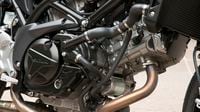The Suzuki SV650 was a Motorcyclist staff favorite. More than half of us have owned SVs, and we've all recommended the bike to others. Repeatedly. So when the SV650 was replaced by the more expensive, heavier, and above all garish Gladius (later renamed the SFV650) in 2009, we were dismayed. With one misguided styling exercise Suzuki took the SV from being the tasty and wholesome snack that everyone loved, to being an over-seasoned dish that few could stomach.
Let’s all breathe a sigh of relief then, because Suzuki has brushed the excess salt off the SV and now has a much more palatable bike. The ugly is gone, replaced by a redesigned tank, tail, seat, headlight, dash, and other parts that more closely resemble the simple and timeless look of earlier models. The new bike is also lighter, more powerful, and less expensive than the SFV650 it replaces.
All that new bodywork is bolted to a bike that is more or less the same machine we’ve always loved, which means a narrow and nimble chassis and a gruff and lively engine. The SV’s ergonomics are just about as middle-of-the-road as they come, so the riding position feels relaxed and neutral. The backswept handlebar puts the grips right where you want them and there’s ample legroom. It’s really a comfortable package, whether you’re cutting through traffic in the city, cruising down the freeway, or cutting up a curvy back road. The low 30.9-inch seat height should prove appealing for shorter riders, though the scooped shape doesn’t let you move around much. Suzuki says a taller, flatter seat will be available as an accessory.
Suzuki added the Easy Start feature from the GSX-S1000 to the SV, so you push the starter button once and the ECM cranks the engine until it fires. Another new feature is the Low RPM Assist function, which feeds in a tiny bit of throttle as the rider lets the clutch. It's basically an evolution of Suzuki's Idle Speed Control, modified and marketed as a rider aid, and after experimenting with it we think it'll probably help timid newbies from stalling the bike as they learn to manage the clutch and throttle.
The engine is as charismatic and punchy as we remember, but with a more nasally intake noise than before. Maybe the new Euro 4-compliant exhaust is just quieter? Suzuki tweaked the SV’s venerable V-twin a bit for 2017, increasing output by a claimed 4 hp. Throttle response is perfect and thrust is strong off the bottom and abundant everywhere in the rev range, but the rhythmic V-twin power pulses begin to blend together at higher revs and the engine feels busy and buzzy above 7,000 rpm. No worries, because 5,000 rpm puts an indicated 70 mph on the new all-digital dash in top gear.
On twisty mountain roads, this new SV is just as fun and willing a dance partner as the original. The bike has the kind of light and direct steering that lets you flick the bike from side to side while remaining centered in the seat. There’s no body language required, and the bike really feels like it’s working with the rider. The engine has the same sort of encouraging personality—just leave it in one gear and revel in the smooth torque, as thick and tasty as a slab of Canadian bacon.
Shifting is slick and smooth and the clutch has progressive engagement, but compared to the super light pull on "slip-grip" clutches the SV's clutch-lever pull is a little heavy for the intended demo. Suspension is basic—they’re the same parts the SV has had since 1999, but with updated spring rates and damping—but works well. The fork reveals its limitations by feeling harsh over hard-edged bumps, but otherwise the suspension is pretty compliant and supportive.
The only real drawback to the bike is the front brake. The Tokico two-piston calipers are 1999-spec and feel that way. There's not much bite, power, or feel, so entering a corner faster than expected can be more exciting than it should be. An ABS model will be available later this summer for an added $500. Many SV owners solved the bike's suspension and brake inadequacies by slapping a GSX-R front end on. (Like we did with this SV650 Streetbike Surgery.) Too bad Suzuki hasn't warmed to that idea yet, because while the SV650 is an undeniably competent bike it needs an edge to take on the Yamaha FZ-07, which is clearly the SV's direct rival.
Compared to the slim and feisty Yamaha FZ-07, the $6,999 SV650 is $9 more expensive, about 30 pounds heavier, and feels about 15 percent larger. Both engines have the same claimed horsepower, but the FZ-07's parallel twin is rowdier and overall the Yamaha feels more rambunctious. The Yamaha is also ultra-compact (read: small) so taller riders may be attracted to the slightly larger SV, which offers more or less the same combination of fun and functionality for a nearly identical price. We don't expect the SV650 to outclass the FZ-07, but we won't know for sure until we ride them back to back.
In the meantime, we're excited to have the SV650 back. It's got the same character and confidence-inspiring performance that we remember, but now with updated styling, a few more ponies, and some novel rider aids. When we last tested the SFV650 in late 2014 (see that MC Comparo here), Senior Editor Zack Courts suggested that "If Suzuki's design staff could trim the fat off the SFV and spruce it up with an aesthetic that's not trying so hard to be cool—while keeping the SFV's fun-loving personality—they would have a winner."
That’s just what Suzuki did, and that’s exactly what we have.











/cloudfront-us-east-1.images.arcpublishing.com/octane/DESCGRWIBQBNWLSR7FS64WPUEA.gif)




/cloudfront-us-east-1.images.arcpublishing.com/octane/GTCXACQGJ5HAPDTGWUQKDEH44E.jpg)
/cloudfront-us-east-1.images.arcpublishing.com/octane/S35YGSEMEZB4BLTDJTSZPF4GLA.jpg)
/cloudfront-us-east-1.images.arcpublishing.com/octane/5UOT6HPX2JFMRJAX6EH45AR4MQ.jpg)
/cloudfront-us-east-1.images.arcpublishing.com/octane/OKWOJWAKP5EP3OACCRRWPCIX2Q.jpg)
/cloudfront-us-east-1.images.arcpublishing.com/octane/2WF3SCE3NFBQXLDNJM7KMXA45E.jpg)
/cloudfront-us-east-1.images.arcpublishing.com/octane/G4MG6OUCJNBSHIS2MVVOTPX65E.jpg)
/cloudfront-us-east-1.images.arcpublishing.com/octane/IIGGWFOTOJGB7DB6DGBXCCMTDY.jpg)
/cloudfront-us-east-1.images.arcpublishing.com/octane/QSTCM6AVEZA5JJBUXNIQ3DSOF4.jpg)
/cloudfront-us-east-1.images.arcpublishing.com/octane/U4I7G625B5DMLF2DVIJDFZVV6M.jpg)
/cloudfront-us-east-1.images.arcpublishing.com/octane/B6XD6LS6IVCQPIU6HXDJSM3FHY.jpg)
/cloudfront-us-east-1.images.arcpublishing.com/octane/ICL63FEDDRDTTMINYICCEYGMDA.jpg)
/cloudfront-us-east-1.images.arcpublishing.com/octane/FCGZHQXRBZFLBAPC5SDIQLVF4I.jpg)
/cloudfront-us-east-1.images.arcpublishing.com/octane/WNOB6LDOIFFHJKPSVIWDYUGOPM.jpg)

/cloudfront-us-east-1.images.arcpublishing.com/octane/X33NU3E525ECRHXLNUJN2FTRKI.jpg)
/cloudfront-us-east-1.images.arcpublishing.com/octane/6KKT5NNL2JAVBOXMZYS5ZO76YA.jpg)
/cloudfront-us-east-1.images.arcpublishing.com/octane/J5RKG5O455GMPGQRF2OG6LRT7A.jpg)
/cloudfront-us-east-1.images.arcpublishing.com/octane/GX2CIZKQVRH2TATDM26KFG2DAE.jpg)
/cloudfront-us-east-1.images.arcpublishing.com/octane/ZWIDYSAKQZHD5BHREMQILXJCGM.jpg)
/cloudfront-us-east-1.images.arcpublishing.com/octane/CYUHJZCTSJCH3MRAQEIKXK7SCQ.jpg)
/cloudfront-us-east-1.images.arcpublishing.com/octane/LKOFINY56FCXJCANJ5M7ZDQUBY.jpg)
/cloudfront-us-east-1.images.arcpublishing.com/octane/4NBPDACMWJH63JQYJVK3QRBDZI.jpg)
/cloudfront-us-east-1.images.arcpublishing.com/octane/KKHQHRR3FJGX7H2IPU6RALMWG4.jpg)
